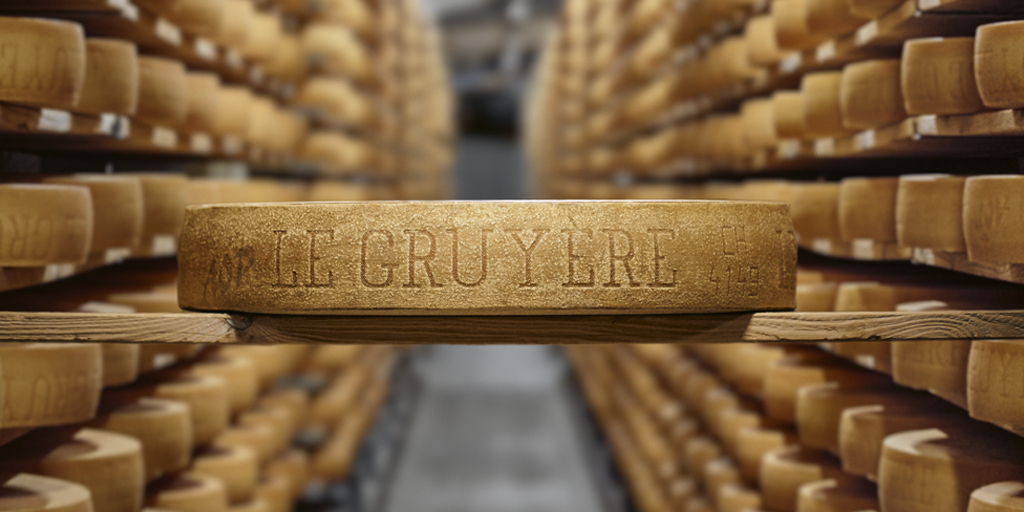When it comes to culinary indulgence, few things can match the exquisite pleasure of pairing fine cheese with a sparkling glass of champagne. [read the full champagne story]
Estimated reading time: 7 minutes

The juxtaposition of flavors, textures, and aromas creates a symphony for the senses.
In this gastronomic journey, we’ll explore the luxurious world of Gruyère cheese and champagne, delving into their individual characteristics, their compatibility as a pairing, and the art of savoring these two treasures.
Gruyère Cheese: A Swiss Masterpiece
Gruyère cheese is a Swiss culinary treasure with a rich history dating back to the 12th century. Named after the picturesque Gruyères region in Switzerland, this cheese is characterized by its pale yellow hue, firm texture, and complex flavor profile. The distinct nutty and slightly sweet taste of Gruyère cheese is a result of the high-quality cow’s milk used in its production, typically from cows that graze on the lush Alpine pastures.
The cheese-making process involves precise craftsmanship and adherence to tradition. The milk is heated, curdled, and pressed into wheels that weigh up to 88 pounds. These wheels are then aged for several months, often in cool and humid cellars, which impart distinct characteristics to the cheese.
The aged Gruyère cheese develops small, round holes, or “eyes,” and a firm, straw-colored interior. The texture varies depending on the aging process, ranging from semi-firm for younger cheeses to crumbly and crystalline for more aged varieties.
The flavor also intensifies with age, evolving from a mild, nutty sweetness to a more complex, earthy and slightly salty profile.
Lés pâtés pressé – pressed cheeses
Family which in Swedish is called hard cheeses. The name has its origin in the manufacturing process of these cheeses: in order to remove water from the curd, the cheese is pressed one or more times. The curd can be normally tempered (non cuit) or heated (cuit). Most ‘pâtes pressées’ are hard cheeses of very large format, eg Comté 35-55 kg / cheese or Emmental up to 130 kg / cheese. Plenty of summer milk must be taken care of and in addition, the large cheeses were well preserved during the winter.
In this family we find, for example, the following cheeses:
- France: Abondance, Appenzeller, Cantal, Comté, Beaufort, Fouchtra de Vache, Mimolette, Murol, Ossau Iraty, Pavin, Rebluchon, Morbier, and Saint-Nectaire, Tomme de Savoie.
- English: Cheddar.
- Switzerland: Gruyère, Vacherin Fribourgeoise, Appenzeller. Italy: Prmigiano Reggiano, Grana Padano, Pecorino, Pantaleo.
- Spain: Manchego.
- Sweden: Västerbotten, Magré, Grevé or Herrgårdsost. Yes, pretty much all of our Swedish hard cheeses.

Champagne: The Elixir of Celebration
Champagne, often referred to as the “drink of kings” or “nectar of the gods,” has a history intertwined with luxury and celebration. This effervescent wine hails from the Champagne region of France and is renowned for its exceptional quality and unique production process.
The primary grape varieties used in champagne production are Chardonnay, Pinot Noir, and Pinot Meunier. What sets champagne apart from other sparkling wines is its secondary fermentation process in the bottle, known as the méthode champenoise. During this process, a mixture of sugar and yeast is added to the base wine, which produces carbon dioxide, creating the iconic bubbles that champagne is famous for.
Champagne comes in various styles, from the crisp and citrusy Blanc de Blancs made solely from Chardonnay grapes to the fuller-bodied Blanc de Noirs produced from red Pinot Noir or Pinot Meunier grapes. There are also the classic Brut, Extra Brut, and Demi-Sec variations, each with its own sweetness level to cater to a wide range of preferences.
The Perfect Marriage: Gruyère Cheese and Champagne
The synergy between Gruyère cheese and champagne lies in their complementary characteristics. This pairing exemplifies the age-old culinary wisdom that opposites attract. Let’s examine how these two delicacies interact on the palate and why they create such a harmonious union:
Subscribe for 5.9€ a month for full access to the Tasting Library, exclusive articles, videos events and more





